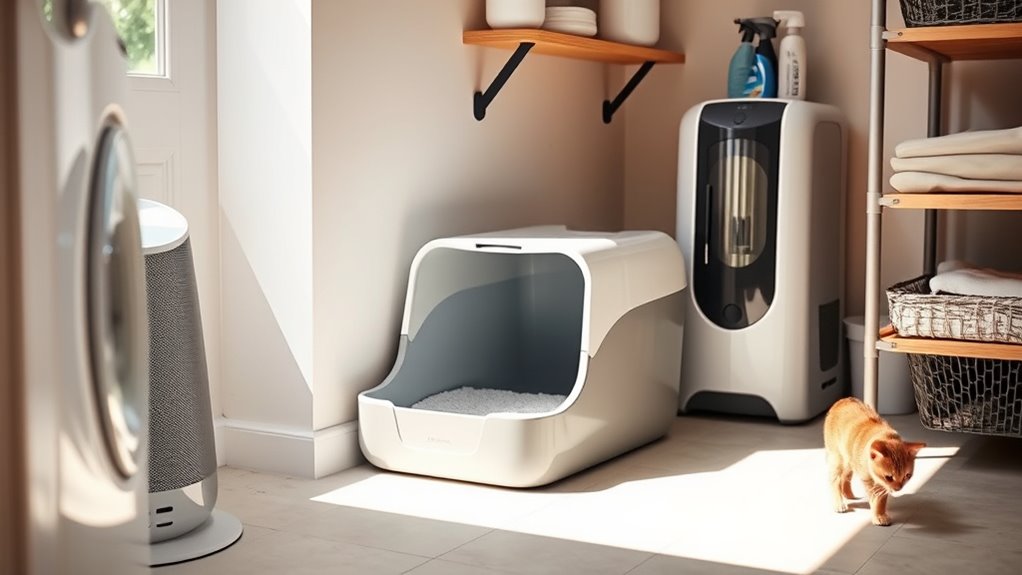Many cat owners make mistakes like using the wrong type of litter, not scooping often enough, or overfilling the box, which trap odors. Choosing poor location and neglecting regular cleaning also make smells worse. Skipping prompt litter replacement or ignoring proper ventilation worsens the issue. Assuming all brands are equal or overlooking additional odor absorbers can cause persistent smells. Keep going to discover more tips to keep your home fresh and odor-free.
Key Takeaways
- Using the wrong litter type or inadequate depth can trap odors and discourage proper cleaning.
- Infrequent scooping and cleaning allow bacteria and waste odors to build up quickly.
- Poor placement and ventilation trap odors, making odor control ineffective.
- Relying solely on scented litter or deodorizers masks, rather than neutralizes, odors.
- Neglecting additional odor-absorbing measures like air purifiers reduces overall effectiveness.
Using the Wrong Type of Litter for Odor Control
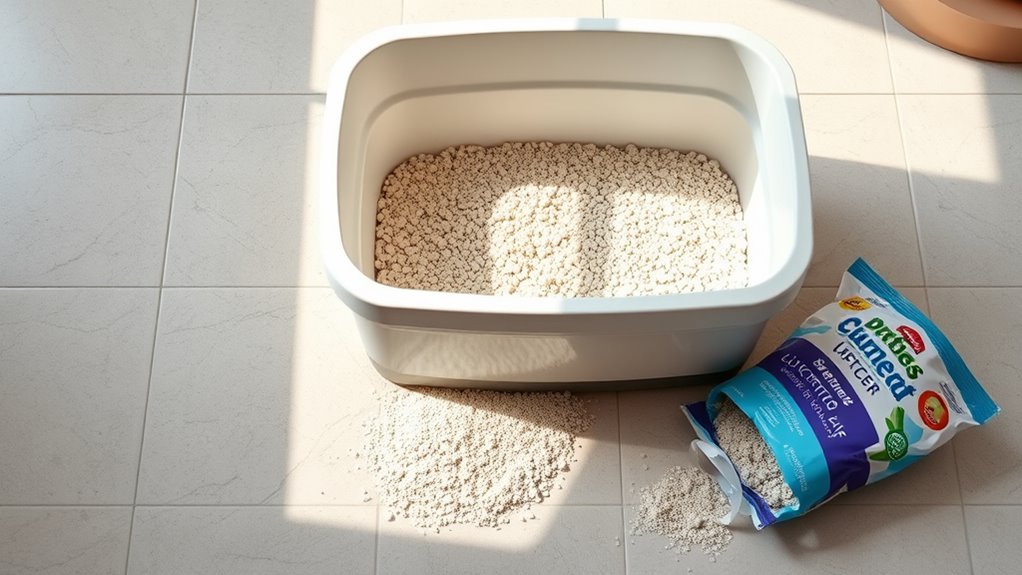
Choosing the right type of cat litter is essential for effective odor control. You often face the choice between clumping and non-clumping litter, each with pros and cons. Clumping litter makes scooping easier and traps odors better, but some cats dislike its texture. Non-clumping absorbs moisture but needs more frequent changes to control smells. You also decide between scented and unscented options. Scented litter masks odors but may irritate sensitive cats or noses, while unscented litter offers a more natural approach, often with better odor absorption. Picking the wrong type can lead to lingering smells and unhappy cats. Consider your cat’s preferences and your cleaning routine to select the best litter for odor control, avoiding ineffective choices that worsen odors instead of reducing them. Using the right wall organization system can also help keep your space tidy and odor-free.
Not Scooping Frequently Enough

If you wait too long to scoop, odors will quickly become noticeable. Bacteria start to grow and multiply when waste sits, making smells worse. Regular scooping keeps your litter fresh and prevents bacterial buildup. Additionally, using high-quality litter odor control products can further reduce unpleasant smells.
Delay Leads to Odors
Waiting too long to scoop your cat’s litter can quickly lead to strong odors that make your home unpleasant. Timing delays in cleaning allow waste to sit longer, resulting in odor escalation. The longer you wait, the more intense the smell becomes, making it harder to control later. To help visualize, here’s a quick guide:
| Delay Duration | Odor Level | Recommended Action |
|---|---|---|
| Less than 24 hrs | Mild | Scoop immediately |
| 1-2 days | Noticeable | Clean and refresh |
| 3-4 days | Strong | Deep clean the box |
| 5+ days | Overpowering | Replace litter & clean |
| Excessive delay | Severe | Full cleaning required |
Avoid these delays to prevent odor escalation and keep your home smelling fresh. Regular maintenance is key, as proper timing can significantly reduce odor buildup and improve your cat’s environment.
Bacterial Growth Accelerates
When you neglect to scoop your cat’s litter regularly, bacteria quickly start to multiply within the box. This rapid bacterial growth intensifies odors and creates a less hygienic environment. Over time, the smell becomes harder to control, even with deodorants. Using antibacterial sprays can help reduce bacteria, but they aren’t a substitute for frequent scooping. Incorporate odor neutralizing mats around the litter box to absorb residual odors and prevent bacteria from spreading. These mats trap bacteria and odor particles, making cleanup easier and maintaining a fresher space. The key is consistency—scoop daily to inhibit bacterial growth and keep odors at bay. Regular maintenance not only improves odor control but also promotes your cat’s health and comfort. Additionally, bacterial growth rates are influenced by temperature and humidity, so maintaining a cool, dry environment around the litter box can help slow bacterial proliferation.
Overfilling the Litter Box
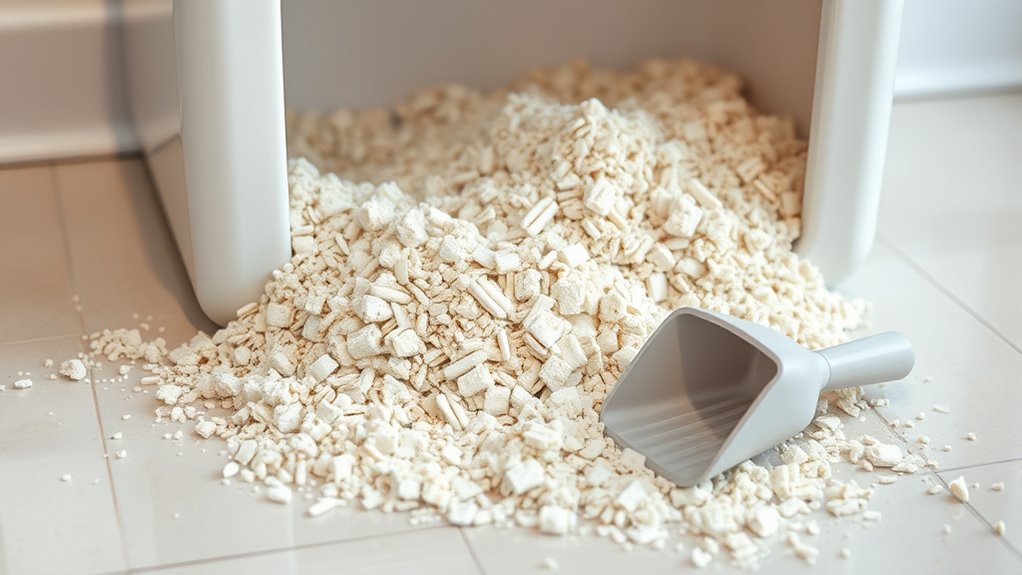
Overfilling the litter box can actually make odor control worse rather than better. When you add excessive litter volume, it becomes harder for your cat to dig and cover waste properly. This can lead to waste sitting on top, increasing odor. Litter box overfilling also prevents proper airflow and ventilation, trapping smells inside. Plus, excessive litter can make cleaning more difficult, leading to missed spots where odors linger. Instead, use a moderate amount—about 2-3 inches of fresh litter—to ensure your cat has enough material to bury waste and for odor absorption. Maintaining the right litter level promotes better waste coverage, reduces odor buildup, and makes cleaning easier. Remember, more isn’t always better; proper litter depth is key to odor control. Additionally, choosing innovative materials that enhance odor absorption can further improve your litter box experience.
Skipping Regular Cleaning of the Litter Box
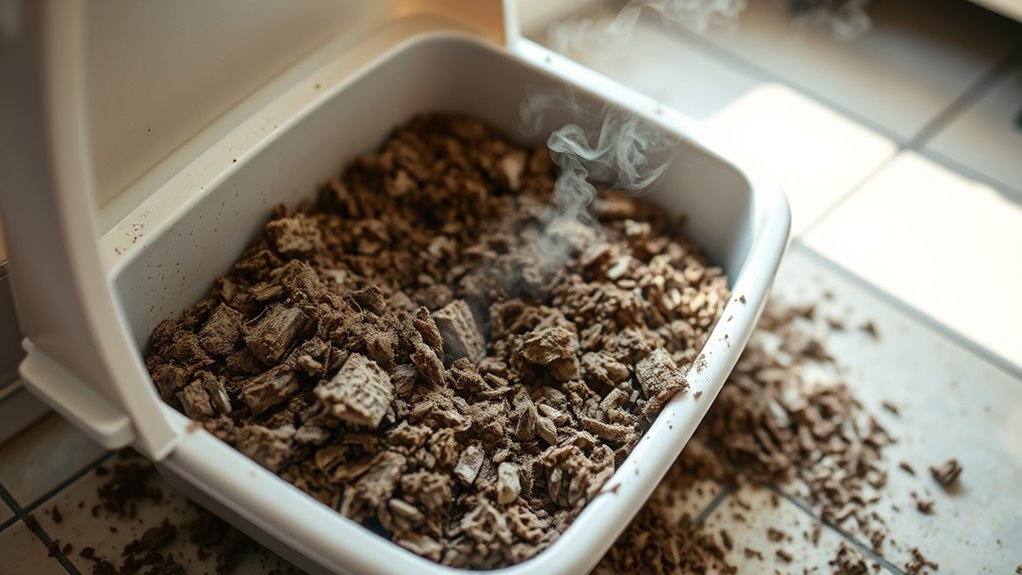
Neglecting to clean the litter box regularly allows odors to build up quickly, making your home smell unpleasant. Skipping routine maintenance not only causes bad smells but also makes odor prevention harder. You might think occasional cleaning is enough, but daily scooping and weekly deep cleans are essential to keep odors in check. When you neglect regular cleaning, waste and bacteria accumulate, intensifying the smell and creating an unhealthy environment for your cat. Regular cleaning also helps prevent the buildup of bacterial growth, which can worsen odors and affect your cat’s health. Consistent maintenance ensures the litter stays fresh and controls odor effectively. By sticking to a cleaning schedule, you prevent odor problems before they start, saving you from more difficult and time-consuming cleanups later. Regular cleaning is a simple yet crucial step in maintaining a fresh, odor-free home for both you and your feline friend.
Choosing the Wrong Location for the Litter Box

Placing your cat’s litter box near high-traffic areas can make it less appealing and lead to messes. Hiding it in a spot with poor ventilation traps odors and makes cleanup harder. Choosing the wrong location can turn litter box maintenance into a constant battle. Additionally, selecting an area without adequate ventilation can diminish the effectiveness of odor control and contribute to lingering smells.
Placement Near High Traffic
Choosing a location for your cat’s litter box is crucial, but placing it in a high-traffic area can lead to ongoing odor issues and inconvenience. Placement near high traffic exposes your cat and household members to constant noise disturbance, making the box less inviting for your feline. When the litter box is in a busy spot, it’s more likely to be overlooked or moved, causing inconsistent cleaning and odor buildup. Additionally, the constant activity can stress your cat, leading to accidents outside the box and further odor problems. Avoid placing the litter box where people frequently pass, as this discourages regular maintenance and increases frustration. Instead, choose a quiet, low-traffic corner that provides privacy, reduces noise disturbance, and helps keep odors contained. Regularly cleaning and maintenance are essential to prevent persistent odors and ensure your cat remains comfortable.
Hidden Spots Reduce Ventilation
When you hide the litter box in a tucked-away corner or behind furniture, you limit airflow and ventilation, causing odors to linger and intensify. Poor placement reduces ventilation gaps around the box, preventing fresh air from circulating effectively. Without proper air circulation, odors become trapped, making your space smell worse over time. Choosing a location that’s too secluded can also trap moisture and ammonia fumes, which worsens the smell. Instead, opt for a spot with good ventilation and easy access, where air can flow freely around the litter box. This improves ventilation gaps and helps disperse odors quickly. Ensuring proper air circulation is key to controlling litter box smell and maintaining a fresher environment for both you and your cat. Proper placement also considers ventilation and airflow, which are essential for reducing odors and keeping your space fresh.
Using Scented Litter or Deodorizers That Don’t Work
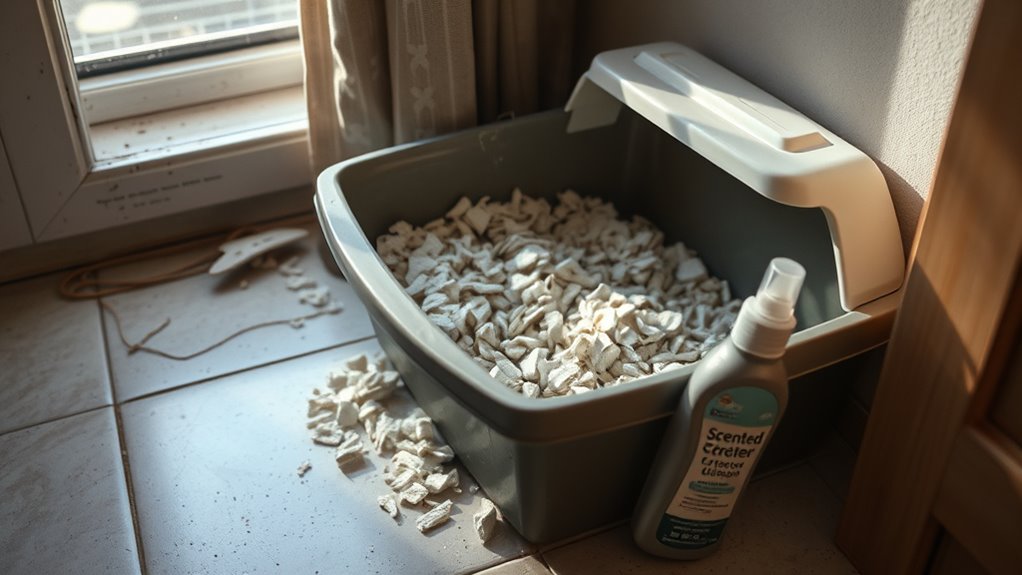
While scented litter and deodorizers may seem like an easy fix, they often fall short in controlling odor effectively. Scented litter can mask smells temporarily, but it doesn’t eliminate the source of odor, leading to lingering smells. Similarly, many deodorizers promise strong deodorizer effectiveness but fail to neutralize odors completely. Instead, they might just cover up the smell, which can be especially frustrating if your cat’s litter box is still emitting unpleasant odors. Relying solely on scented products can create a false sense of security, making you overlook underlying issues like dirty litter or poor ventilation. To truly control odor, focus on proper cleaning, good ventilation, and choosing litter that naturally suppresses odors rather than just masking them. Proper soil and ventilation are crucial for odor control in maintaining a fresh-smelling home.
Failing to Replace Old Litter Promptly
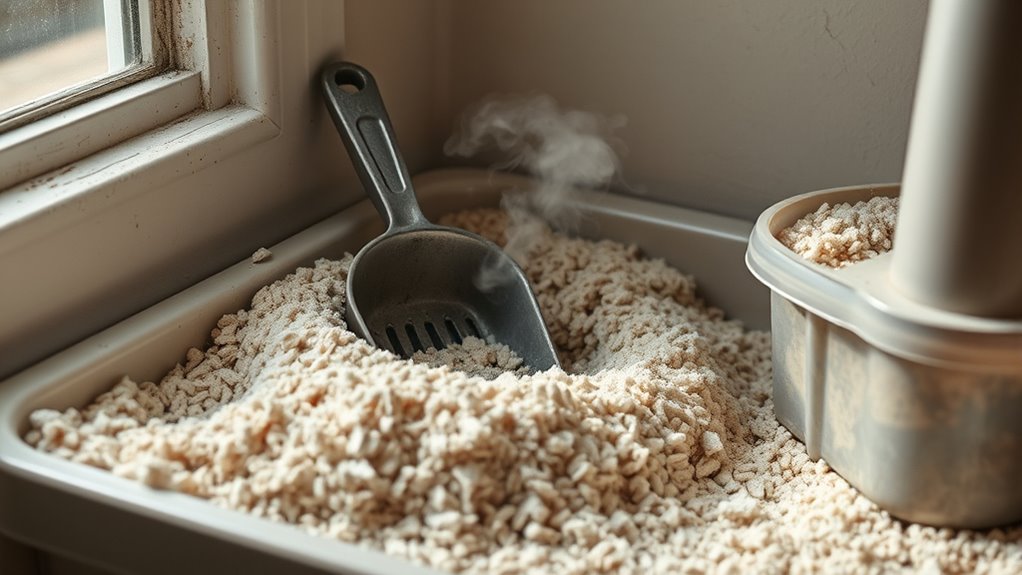
When you wait too long to change your cat’s litter, odors can quickly build up and become overwhelming. Old litter loses its ability to clump effectively, making it harder to keep the box clean. Prompt replacements help control smells and keep your cat comfortable. Using fresh litter also maintains a cleaner environment, reducing the risk of infections or discomfort for your pet.
Odor Buildup Over Time
Old litter that isn’t replaced regularly quickly accumulates odor-causing bacteria and trapped waste, making your home smell less fresh over time. As the waste and bacteria build up, the odor becomes more persistent, especially if your space lacks proper air circulation. Without fresh air moving through the area, odor molecules linger longer, intensifying the smell. Using a litter with good odor absorption helps, but it can’t fully compensate for neglected litter changes. Over time, the smell seeps into surrounding surfaces and furniture, making it harder to eliminate. To prevent this, replace your litter frequently and ensure good air circulation around the litter box. Doing so minimizes odor buildup, keeps your home smelling fresher, and creates a healthier environment for both you and your cat. Regularly cleaning the litter box and understanding home essentials like proper ventilation can significantly improve odor control.
Reduced Clumping Effectiveness
Failing to replace your cat’s litter promptly can considerably reduce its ability to clump effectively. Over time, moisture accumulates, breaking down the litter’s clumping consistency and making it less reliable. Old litter loses its moisture control properties, causing clumps to break apart easily and scatter when scooping. This not only makes odor control harder but also complicates cleaning. Regularly replacing old litter ensures that moisture stays contained, maintaining strong clumping and odor absorption. If you ignore the need for timely changes, the litter’s effectiveness diminishes, leading to loose, weak clumps and increased odor. To keep your litter performing well, swap it out as recommended and avoid letting it sit too long. This simple step preserves moisture control and ensures your cat’s litter box stays fresh.
Ignoring the Need for a Litter Box With Proper Ventilation
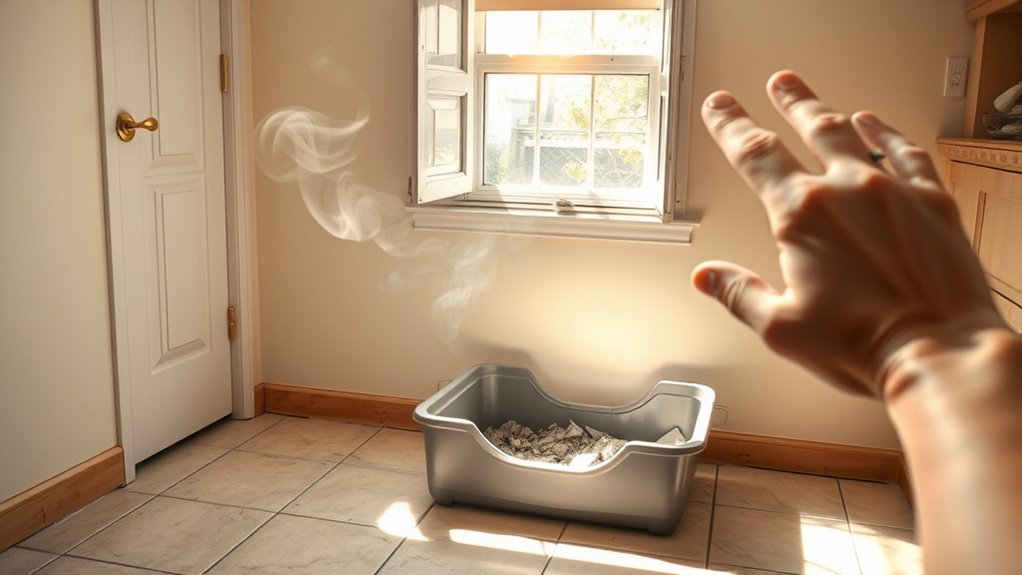
If your litter box lacks proper ventilation, odors can quickly become overwhelming. Without good airflow, ammonia and other smells linger longer, making your home less pleasant. The key is choosing a litter box design that promotes ventilation solutions, such as boxes with built-in vents or adjustable openings. These features help air circulate, reducing trapped odors and keeping the litter fresher longer. Ignoring ventilation needs allows smell to build up, prompting you to clean more often and risking your cat’s comfort. Investing in a well-ventilated litter box isn’t just about odor control; it also supports your cat’s health by reducing airborne irritants. Proper air circulation can significantly improve odor management and overall indoor air quality. Don’t overlook this simple step—improving ventilation is an effective way to keep your home smelling cleaner.
Neglecting Additional Odor Absorbing Measures
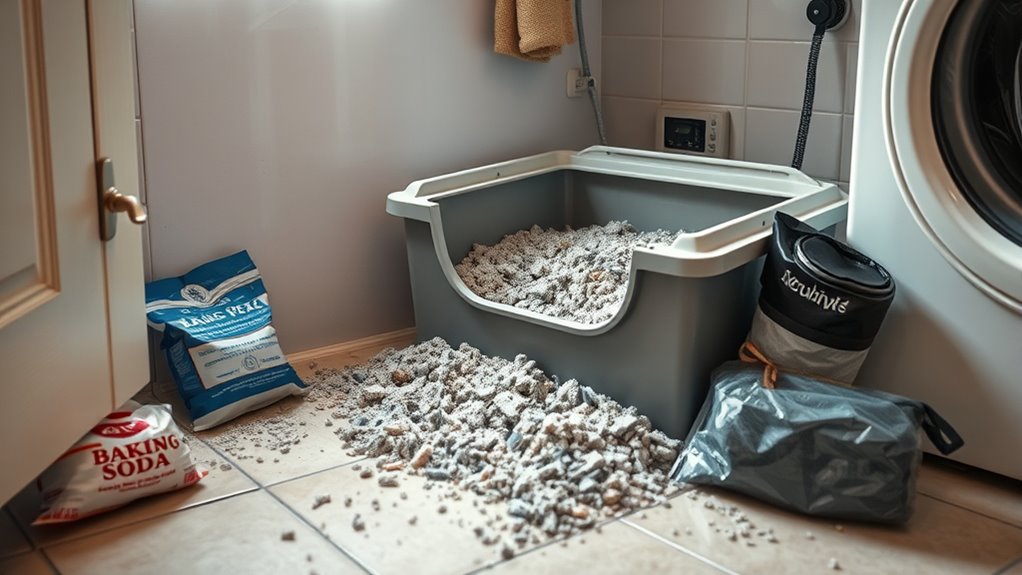
Neglecting to incorporate additional odor absorbing measures can cause lingering smells even if your litter box is well-maintained. Relying solely on regular scooping isn’t enough; you need extra steps. Using an air purifier can help trap airborne odors, while a good ventilation system reduces humidity and disperses smells. Consider placing odor absorbers like charcoal bags or baking soda near the litter box area. These measures can make a big difference in controlling stubborn odors. Proper air circulation is essential for maintaining a fresh-smelling environment, as stagnant air can trap odors. Here’s a quick overview:
| Measure | Effectiveness | Best Placement |
|---|---|---|
| Air purifier | Captures airborne odors | In the room or near litter box |
| Ventilation system | Disperses smell | Near windows or vents |
| Charcoal bags | Absorbs odors | Close to litter box |
Implementing these extra measures helps keep your home smelling fresh.
Assuming All Litter Brands Are Equally Effective
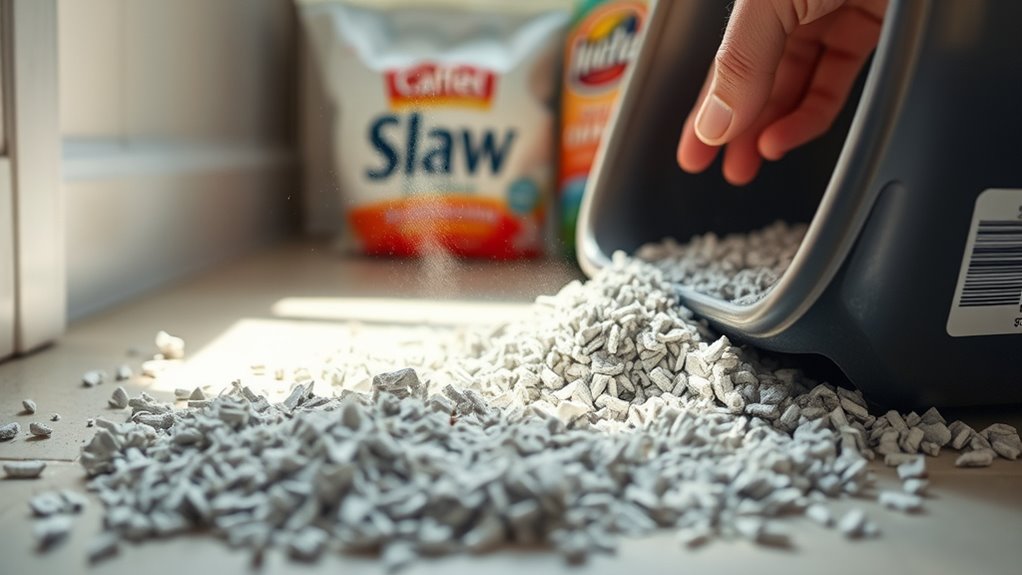
Many pet owners assume that all cat litter brands perform equally when it comes to odor control, but this isn’t the case. Litter brand quality varies markedly, especially in how effectively they manage odors. Not all products incorporate advanced odor control technology, which can make a big difference in odor absorption and neutralization. Some lower-quality litters may seem affordable but fail to contain smells, leading to persistent odors in your home. Higher-quality litters often use specialized additives or clumping formulas designed to trap and eliminate odors more efficiently. By choosing a litter with better odor control technology, you improve your cat’s environment and reduce the need for frequent cleanings. Additionally, understanding the role of attention in selecting the right product can help you make more informed decisions. Don’t assume all brands are the same—investing in quality pays off in odor management.
Frequently Asked Questions
Can the Type of Cat Litter Influence Odor Control Effectiveness?
Yes, the type of cat litter you choose can greatly influence odor control. Litter texture matters—finer or clumping litters trap odors better, while coarser textures might not. Scent additives can also help mask smells, but they aren’t a substitute for good cleaning. Experiment with different types to find one that balances odor control and comfort for your cat. Regular scooping and changing the litter are still essential for fresh-smelling spaces.
How Does the Number of Cats Impact Litter Box Odor Management?
The more cats you have, the more challenging it is to control litter box odor. You should monitor cat behavior, ensuring each cat has enough space and multiple litter boxes if needed. Proper litter box placement is vital; keep boxes in well-ventilated, quiet areas away from feeding spots. Regular cleaning and scooping become even more essential to manage odors effectively when multiple cats share space.
Are There Natural Remedies to Reduce Litter Box Odors?
Sure, natural remedies for litter box odor absorption exist—who knew? You can try baking soda, charcoal, or even citrus peels to naturally neutralize smells. These options work by absorbing odors rather than masking them, giving your home a fresher scent. Just sprinkle or place these remedies near the litter box, and you’ll be surprised how effectively they reduce odors without harsh chemicals, making your space more inviting for both you and your feline friend.
Does the Age or Health of a Cat Affect Litter Odor?
Yes, the age and health of your cat can affect litter odor. Senior cats or those with health issues often have more frequent or messier bathroom habits, which can increase odor. Additionally, health problems like kidney issues or infections may cause abnormal waste, making odors stronger. To manage this, keep their litter box exceptionally clean, provide regular veterinary care, and consider special litters designed for sensitive cats.
What Are the Signs Indicating It’s Time to Replace the Entire Litter Box?
When your litter box becomes a fortress of foul odors and stains, it’s time to replace it. Signs include persistent bad smell despite regular cleaning, cracks or deep scratches that harbor bacteria, and noticeable wear that hampers odor detection. Proper litter box maintenance means knowing when cleaning isn’t enough. Trust your nose and eyes—if they tell you the box is past its prime, don’t wait. A fresh start restores peace and cleanliness.
Conclusion
By avoiding these common mistakes, you’ll notice a fresh, clean home every day. Imagine walking past your litter box—there’s no harsh smell in the air, just a subtle hint of freshness. Proper scoop timing, strategic placement, and regular cleaning act like a well-orchestrated symphony, ensuring odor stays at bay. When you pay attention to the details, your cat’s space stays inviting, and your home stays odor-free—making everyday life a little easier and a lot more pleasant.
